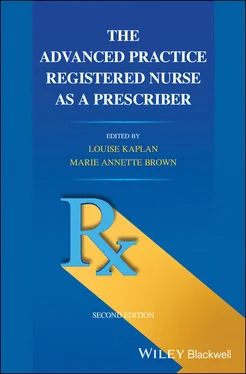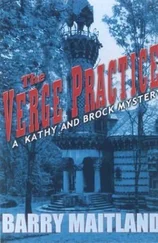1 Kaplan, L., & Brown, M.A. (2004). Prescriptive authority and barriers to NP practice. Nurse Practitioner, 29(3), 28–35.
2 Kaplan, L., & Brown, M.A. (2007). The transition of nurse practitioners to changes in prescriptive authority. Journal of Nursing Scholarship, 39(2), 184–190.
3 Kaplan, L., & Brown, M.A. (2009). Prescribing controlled substances: Perceptions, realities and experiences in Washington State. American Journal for Nurse Practitioners, 12(3), 44–51, 53.
4 Kaplan, L., Brown, M.A., Andrilla, H., & Hart, L.G. (2006). Barriers to autonomous practice. The Nurse Practitioner, 31(1), 57–63.
5 Kaplan, L., Brown, M.A., & Donohue, J.S. (2010). Prescribing controlled substances: How NPs in Washington are making a difference. The Nurse Practitioner, 35(5), 47–53.
6 National Organization of Nurse Practitioner Faculties. (2016). Criteria for evaluation of nurse practitioner programs. Retrieved from https://cdn.ymaws.com/www.nonpf.org/resource/resmgr/docs/evalcriteria2016final.pdf. (Accessed 7 September 2020.)
7 Phillips, S.J. (2020). 32nd annual APRN legislative update: Improving access to high‐quality, safe and effective healthcare. The Nurse Practitioner, 45(1), 28–55.
8 The IQVIA Institute. (2019). Medicine use and spending in the U.S. Retrieved from https://www.iqvia.com/insights/the‐iqvia‐institute/reports/medicine‐use‐and‐spending‐in‐the‐us‐a‐review‐of‐2018‐and‐outlook‐to‐2023. (Accessed 7 September 2020.)
2 Embracing the PrescriberRole as an APRN
Louise Kaplan and Marie Annette Brown
This chapter emphasizes the importance of prescriptive authority as a component of advanced practice registered nurse (APRN) practice. An overview describes the development of, and transition to, the APRN role, with an emphasis on prescribing. The framework for rational prescribing rests on knowledge of the patient, knowledge about the nature of the health problem, and treatment using evidence‐based guidelines, standards of care, and strategies for promoting appropriate medication use.
The ability to independently prescribe medications is a hallmark symbol of the legitimacy of advanced practice registered nurses (APRNs). The public often perceives the prescriber role as what ‘defines’ an APRN. Therefore, a goal of APRNs is full practice authority and professional integrity to provide comprehensive patient care. APRNs prescribe medications not only to meet the needs of individual patients and families but also to meet societal needs and the expectations of a fully autonomous profession like nursing. Prescribing is a component of each of the four APRN roles: certified registered nurse anesthetist (CRNA), certified nurse‐midwife (CNM), clinical nurse specialist (CNS), and nurse practitioner (NP). Prescribing is within the scope of practice for NPs and CNMs in all 50 US states but is more limited for CNSs and CRNAs (National Council of State Boards of Nursing [NCSBN], 2020). This chapter provides information for APRNs to enhance expertise and confidence for successful adoption of the fully autonomous prescriber role.
DEVELOPMENT OF THE APRN ROLE
The APRN role began with nurse anesthetists in the late 1800s, preceding anesthesiologists by several decades. Nurse midwives became established in the United States in the early 1900s, while the CNS role evolved in the 1940s and 1950s (Dunphy, 2018). The NP role, formally developed in 1965, has grown the most rapidly, with NPs becoming the largest group of APRNs. Legislatures enacted laws that provided a scope of practice for APRNs consistent with their educational preparation. Over time, APRNs have established themselves as members of the healthcare workforce with a distinct role, a unique education, and essential knowledge and skills to provide care.
APRN scope of practice varies across the United States according to state laws that are the basis of regulation. Advanced practice nursing is controlled by licensure, accreditation, credentialing, and educational preparation, and practice opportunities which require greater expertise. Variation in APRN roles also results from organizational policies that may support or constrain practice. APRNs are responsible for maintaining a high ethical standard in practice, generating knowledge, and appraising and translating evidence to provide quality, comprehensive, patient‐centered care.
Although there has been significant progress in the utilization of APRNs, constraints on consumers’ access to APRNs, legal limitations, and absence of full practice authority in all states continue to limit APRN practice. Constraints on APRNs that limit their practice are most likely due to concerns about professional competition because extensive data exist about APRN quality of care. For decades, studies have demonstrated that APRN care is as or more effective than care delivered by physicians (Brown & Grimes, 1995; Congressional Budget Office, 1979; DesRoches et al., 2017; Dulisse & Cromwell, 2010; Horrocks et al., 2002; Jennings et al., 2015; Landsperger et al., 2016; Laurant et al., 2018; Lenz et al., 2004; Newhouse et al., 2011; Ohman‐Strickland et al., 2008; Prescott & Driscoll, 1980; Safriet, 1992; Simonson et al., 2007; Spitzer et al., 1974; Wright et al., 2011). Many of these studies also validated widespread acceptance of the APRN role and high satisfaction with APRN care.
Increasing demands for APRNs and assessment of their cost‐effectiveness are powerful factors expected to influence the eventual removal of legal barriers remaining in many states. Concurrently, an improved regulatory environment, especially in relationship to prescriptive authority, has helped legitimize and distinguish the APRN role. In states where NPs have full practice authority which includes complete prescriptive authority, the difference between NPs and physician assistants (PAs) is more apparent and often provides an increased incentive to hire NPs. PA practice, which includes prescribing, is always supervised by and is legally linked with a physician. Furthermore, implementation of the Consensus Model for APRN Regulation, Licensure, Accreditation, Certification and Education (see Chapter 4) can assist APRNs to attain full practice authority.
Autonomy is an important professional concept related to full practice authority. The nursing literature on advanced practice confirms it has been difficult to achieve (Ulrich & Soeken, 2005; Weiland, 2008), mainly due to resistance from organized medicine. Even in the presence of team‐based healthcare, some physicians perceive themselves as the apparent leader or supervisor, which reflects a desire to limit and/or control APRN practice for multiple reasons. Physician control of APRN prescribing often has financial benefits for the physician who is paid for “supervision” that is unnecessary given the educational preparation of APRNs in pharmacotherapeutic content. Physician control of nursing practice is inconsistent with true APRN professional autonomy. Autonomy is also a professional and personal sense of the unfettered ability to make decisions in practice when legally granted to a professional through the endorsement of society. “ Having genuine NP practice ” emerged as the major theme of a qualitative study about NP autonomy that was expressed in four major subthemes: relationships, self‐reliance, self‐empowerment, and defending the NP role (Weiland, 2015). This involved the meaning of the NPs’ practice experience and experience of being an NP. Autonomy extends beyond legal authority. “It is not just in action but in thought that we create our autonomy” (Kaplan & Brown, 2006, p. 37).
DEVELOPMENT OF THE APRN ROLE AND PRESCRIPTIVE AUTHORITY
Prescriptive authority
Читать дальше












